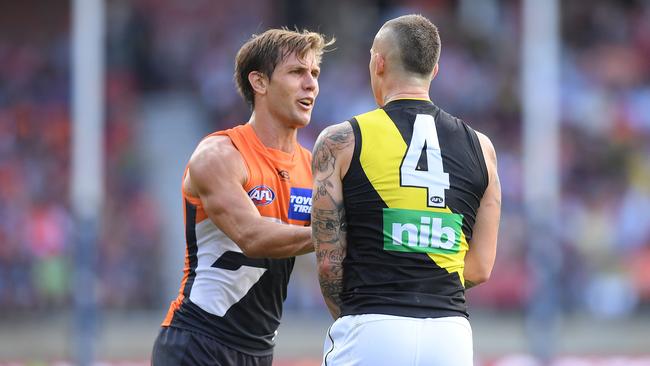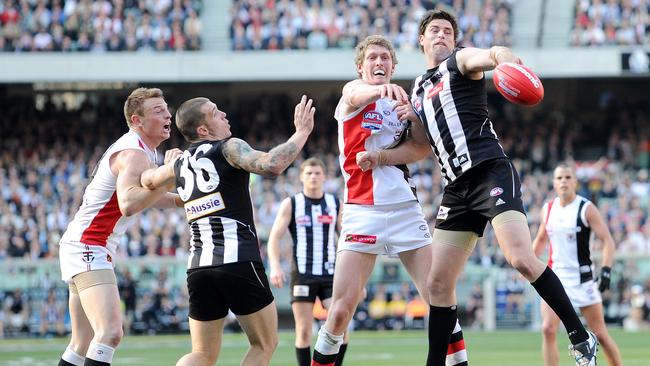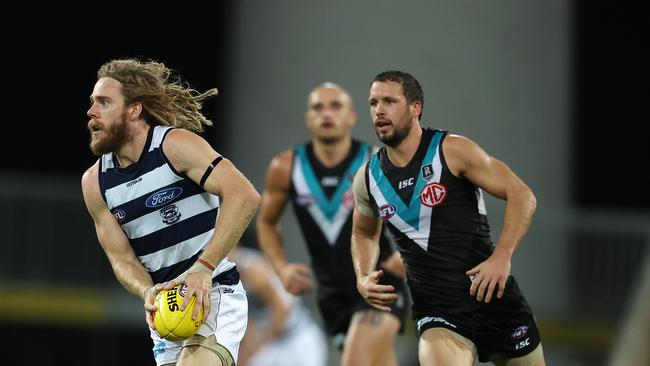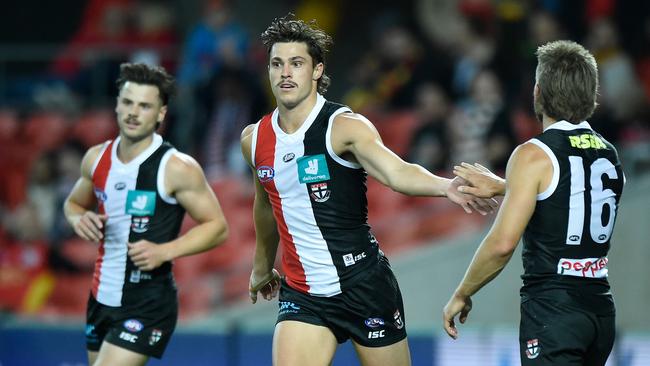Mick Malthouse recalls Dane Swan’s tag on Brendon Goddard in 2010 Grand Final replay and analyses the role of taggers
Coaching great Mick Malthouse analyses the role of taggers in modern football and remembers the day Dane Swan — known for his ball-winning prowess — shut down one of the AFL’s best players to help Collingwood win a flag.

Sport
Don't miss out on the headlines from Sport. Followed categories will be added to My News.
To tag or not to tag?
Richmond won last year’s Grand Final with a whole team effort in defence.
An abundance of very good midfielders allowed the Tigers to work together to dismantle the Giants’ engine room.
They restricted the Giants to a paltry 3.7 (25) — the lowest score in their short history.
It’s not always that easy, so when things go awry it’s handy to have a backup lockdown player in the team.
But before you engage a tagger there are things to consider.
Is it complete lockdown? Does your tagger stick to his opponent for the entire time, in the midfield and when he goes forward?
Do you only tag him when he’s on the ball and leave the backline players to defend when he plays out of the goalsquare?
Do you tag the feeder or the fed? The player who wins the ball and hands it off to his running teammates, or the outside running player?
Do you tag just at stoppages?
Watch Footy LIVE & On-Demand Every Day from July 29 – August 17 with Kayo. New to Kayo? Get your 14-day free trial & start streaming instantly >

Do you tag only when your opponent crosses the centre line and is going forward?
You also need to look at the type of player to be tagged.
Is he a lighter body? Like a Lachie Neale, Luke Shuey, Steele Sidebottom, Adam Treloar, Joel Selwood or Travis Boak.
Or a bigger body like Patrick Dangerfield, Dustin Martin, Patrick Cripps, Nat Fyfe or Elliot Yeo?
There is a place in most teams, on most occasions, for a tagger to be used. But it’s not just a matter of having a tagging type on your list. Each week and each opponent requires a different plan.
The Inside 50: Sign up for The Herald Sun’s AFL newsletter
Sometimes that plan changes part way through a game when you identify where the opposition is causing the most damage.
In the 2010 Grand Final replay I asked Dane Swan to tag St Kilda’s Brendon Goddard in the second half.
Goddard got the Saints back into the match the week before and he was starting to gain momentum again, so I asked Swan to stop him. He did such an outstanding job it went a long way to ensuring we won.

Having a tagging option is a security blanket, if you like, when an opposition player is dominating.
It’s security for when your midfield can’t go head-to-head with the opposition’s midfield.
It’s also allowing the tagger to be creative until he’s called on to go into lockdown mode.
One of the best taggers in the league is St Kilda’s Jack Steele. He is the mainstay of the Saints’ defence as not only a stopper, but also as a possession gatherer and goal kicker.
He averages 22 disposals and five clearances a game and has kicked five goals this season, while tagging and restricting dangerous opponents. Outstanding.
Giant Matt de Boer is another wonderful tagger. His job is simply to lockdown any opponent he is matched against. Without a target de Boar doesn’t get a lot of the ball, so he is best used as a stopper.
The Cats use Cameron Guthrie in a similar role. With the likes of Dangerfield, Selwood and Mitch Duncan in the midfield, and only if there’s trouble, he is employed to tag and make the troublesome opponent less valuable to his team.

Mark Hutchings had the job on Sidebottom in the 2018 Grand Final and proved the worth of an excellent tagger. The Magpie vice-captain had picked up 41 disposals in the preliminary final win against Richmond. But when tagged the next week he gathered just 14 as West Coast snatched victory by five points.
Tagging is not just about stopping the opposition’s best player, but rather, limiting the opposition’s most dominant or dangerous player, on the day.
I always liked to target the captain of the opposing team. The skipper needs not just to play well each week, but to also lift the spirits of his teammates. When he is put under direct pressure from a run-with player it can impede his ability to play and lead well.
This year there is an abundance of good midfielders in good form, but they would each need to be tagged differently.
Brisbane is the beneficiary of Neale’s outstanding form but it is rare for him to be tagged.
Chris Fagan would like to know, before finals, how his star midfielder would respond to a tight tag.
If his output was affected, Fagan would need a back-up plan, and I would want that in place before finding out in a do-or-die final that I needed one.
Against teams like Collingwood, Geelong, West Coast and Greater Western Sydney — teams with an abundance of top-quality midfielders — you need a tagger with the flexibility to switch opponents.
Someone like Scott Pendlebury is hard to stop.
He averages 25 disposals and four clearances this season, and a tagger may only shave off four or five disposals and one clearance.
So perhaps, against the Magpies the tag would have more impact on an outside runner like Treloar, or a hard nut like Taylor Adams, or on a Sidebottom who creates so many opportunities for other players.

A tagger may need to be switched around to accommodate what is going on in the game.
Cripps, Fyfe, Dangerfield, Martin and Western Bulldogs captain Marcus Bontempelli are taller, bigger midfielders who can hold their position and often play out of the goalsquare, requiring different tagging tactics again.
Most taggers are medium-sized players, but the last thing you need is a medium-sized tagger trying to defend these players near goal. That’s when they need special backline attention, so the tagger hands his opponent over to the bigger, seasoned defenders.
It’s a good tactic to throw off a tag to send these stars forward, but if the opposition is a step ahead they can easily switch when this happens.
Players like Neale, Shuey, Boak, Ben Cunnington, Trent Cotchin, Jack Macrae and Tom Mitchell are in and under at the feet of the ruckman and close to the action.
Teammates of these players do anything to block a tagger out of his role. So not only does a tagger in this instance need to be single minded, he has to be able to shrug off the buffeting, blocking, and grabbing he receives.
It is so important here for the tagger to think about where his opponent wants to receive the ball in a stoppage, so he can be first to that space.

The hardest player to tag is one that’s constantly on the move. Tim Kelly, Josh Kelly, Shaun Higgins, Clayton Oliver and Zach Merrett never stop to become an easy target. The tagger on them needs endurance, stamina, awareness, speed and skill.
Two of the best taggers I’ve seen were offensive players turned taggers — Paul Licuria and Cameron Ling.
Among many big-name scalps for Licuria was Josh Francou. He was the Brownlow Medal favourite in 2002 when we headed to Adelaide to take on flag fancy Port Adelaide in a qualifying final. By the end of the game Licuria had 40 disposals, Francou 27, and we won. That’s a job well done.
There is some reluctance in modern day football for coaches to use a tagger, a so-called “negative player”. I don’t get it and I never will.
The tagging role is not easy and stats don’t always reflect its significance. But if he can even just impact the quality of possessions and quality of delivery of a dominant opponent, then it puts the tagger’s team in a better position to win.
And that makes it a job worth doing.
MORE AFL NEWS:
AFL fixture 2020: Winners and losers from Round 14-18 fixture
Riewoldt: Carlton’s young midfield brigade must step up to support Patrick Cripps
Originally published as Mick Malthouse recalls Dane Swan’s tag on Brendon Goddard in 2010 Grand Final replay and analyses the role of taggers
